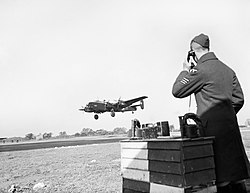| RAF Holme-on-Spalding Moor | |||||||||||
|---|---|---|---|---|---|---|---|---|---|---|---|
| Holme-on-Spalding-Moor, East Riding of Yorkshire in England | |||||||||||
 A sergeant on flying control duty reports the landing of a Halifax Mk V of No. 1663 Heavy Conversion Unit at Holme-on-Spalding Moor, 21 October 1943 | |||||||||||
| Site information | |||||||||||
| Type | Royal Air Force station parent station 1941-43 44 Base HQ 1943-45 | ||||||||||
| Code | HM [1] | ||||||||||
| Owner | Ministry of Defence | ||||||||||
| Operator | Royal Air Force United States Air Force | ||||||||||
| Controlled by | RAF Bomber Command * No. 1 Group RAF * No. 4 Group RAF RAF Transport Command | ||||||||||
| Location | |||||||||||
| Coordinates | 53°48′22″N00°44′31″W / 53.80611°N 0.74194°W | ||||||||||
| Site history | |||||||||||
| Built | 1940/41 | ||||||||||
| In use | 1941 - 1983 | ||||||||||
| Battles/wars | European theatre of World War II | ||||||||||
| Airfield information | |||||||||||
| Elevation | 3 metres (10 ft) [1] AMSL | ||||||||||
| |||||||||||
RAF Holme-on-Spalding Moor, or more simply RAF Holme is a former Royal Air Force station located in Holme-on-Spalding-Moor, East Riding of Yorkshire, England.
Contents
- Second World War
- Construction and layout
- Operational command and allocated units
- Officers Commanding
- Cold War
- Blackburn and British Aerospace
- Current use
- References
- Notes
- Citations
- Bibliography
The site was built during the Second World War, it was used during the war by the Royal Air Force (RAF) as a bomber station, and after the war as a transport airfield and bomb store before being "mothballed". In the 1950s, the RAF used the station as a training camp before it was transferred to the United States Air Force (USAF) as a reserve station during the Cold War. After USAF use, it became a testing airfield for Blackburn Aircraft and its successor British Aerospace until 1983, when the airfield was closed. Many of the airfield buildings survive as an industrial estate, but most of the runways have been demolished.



